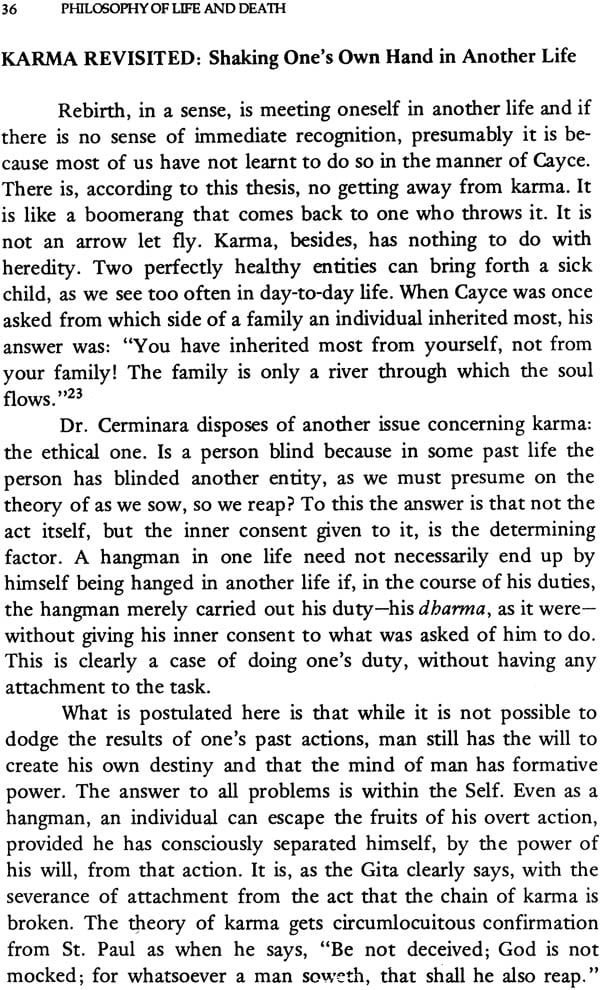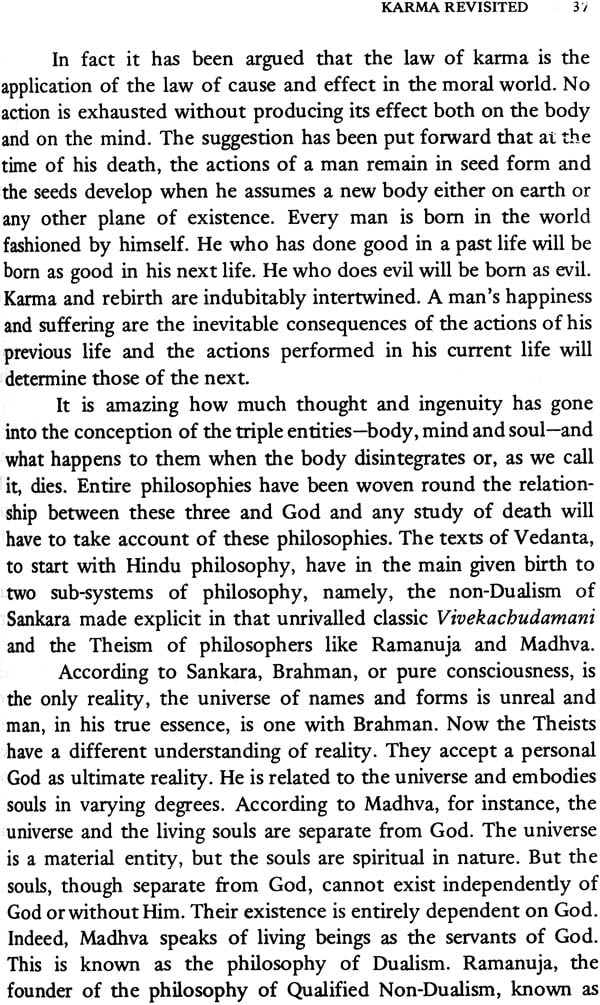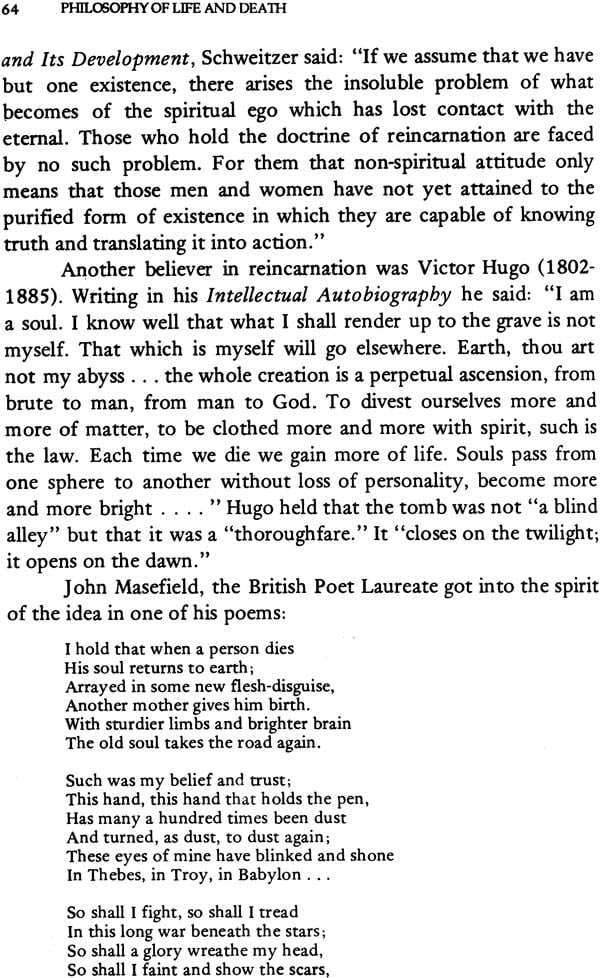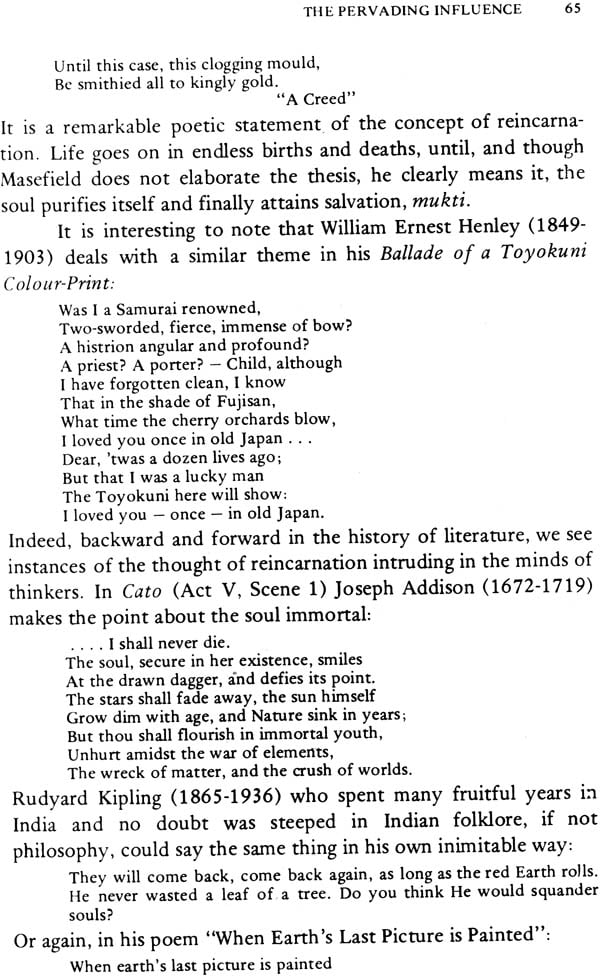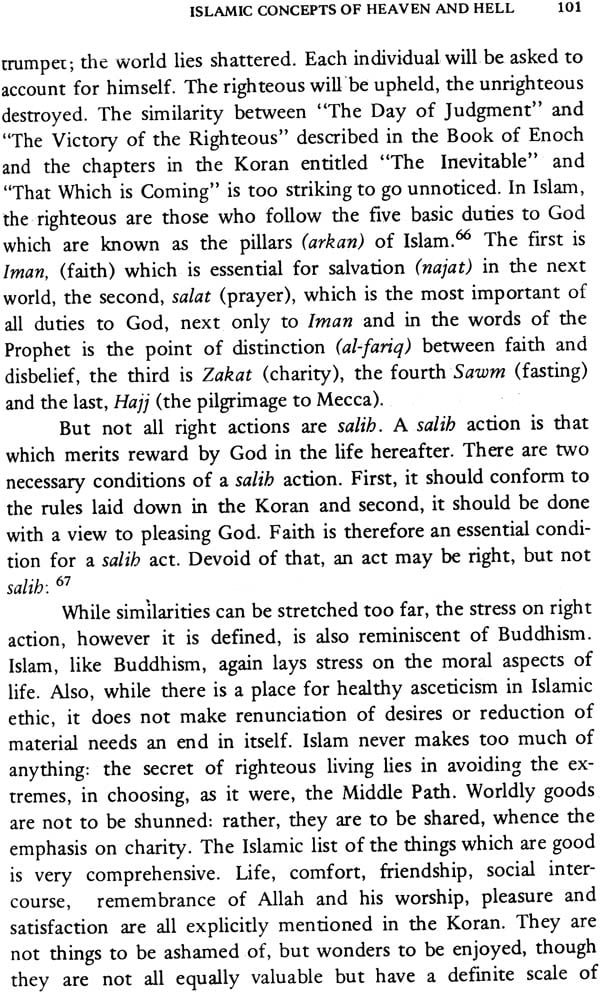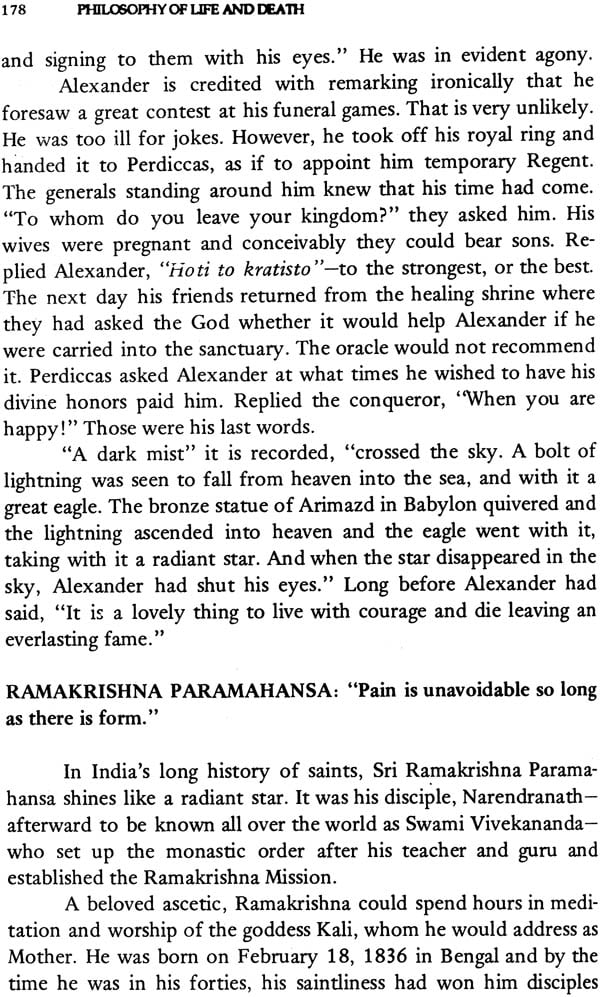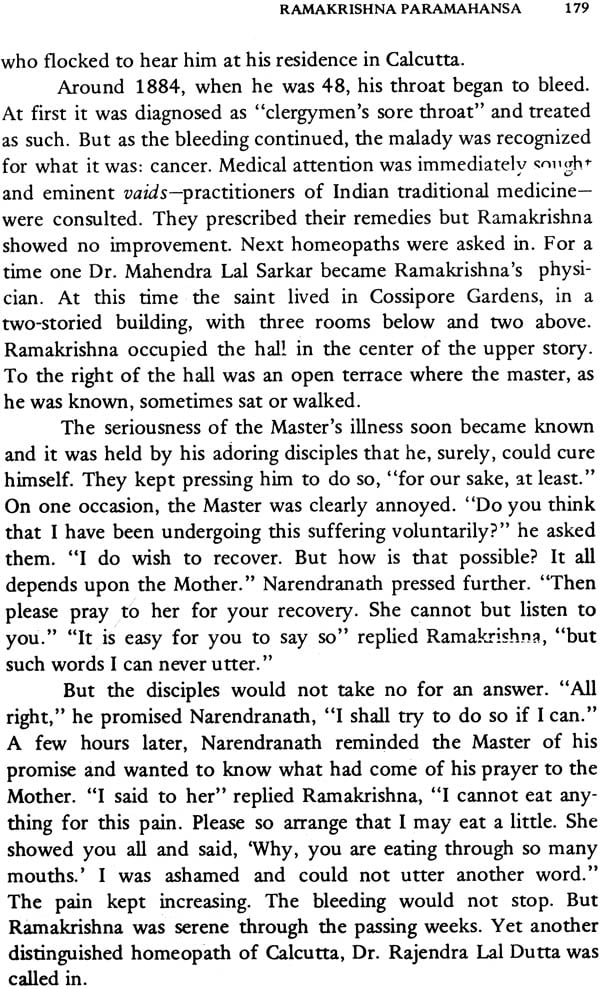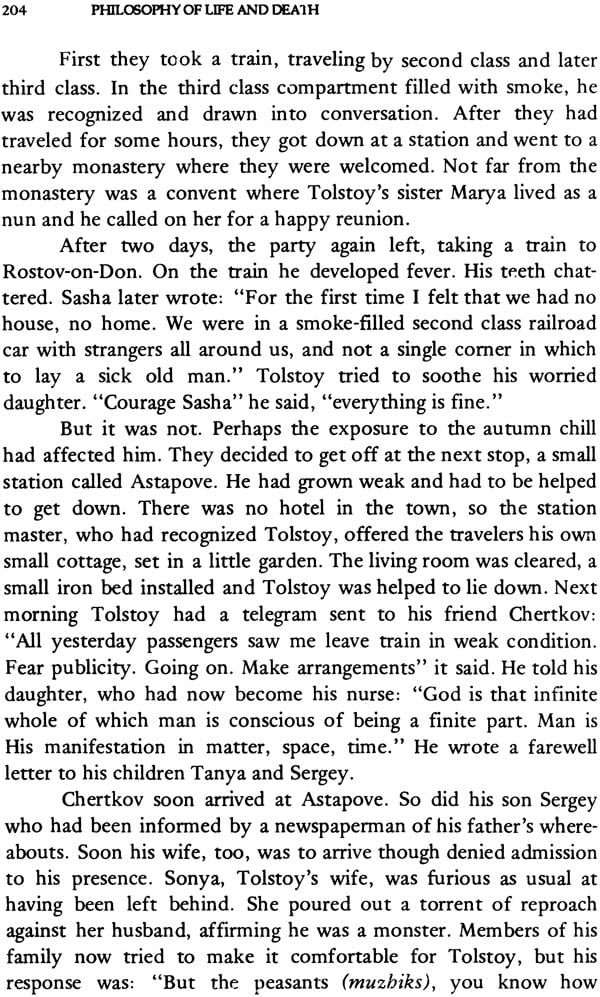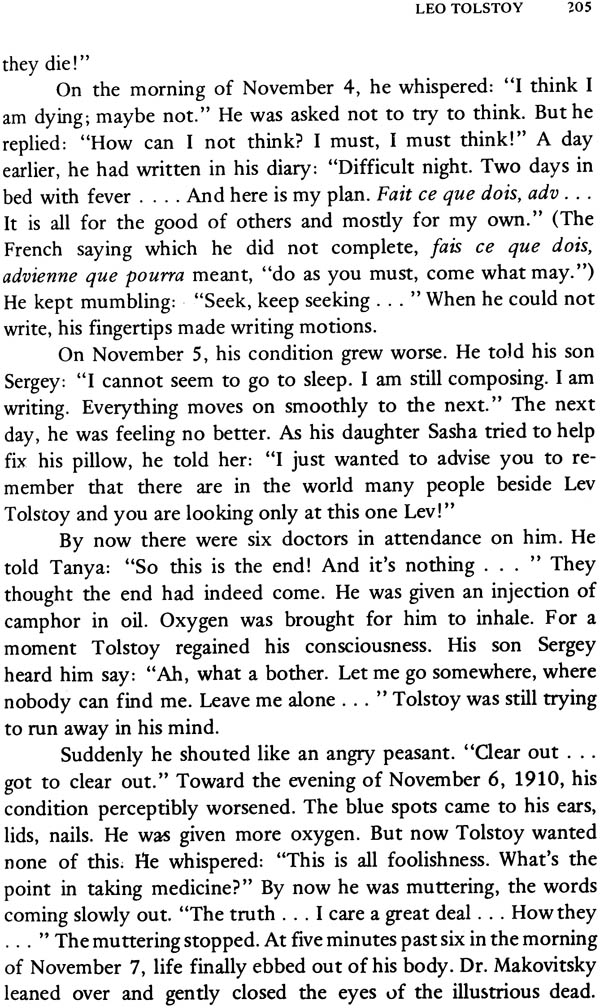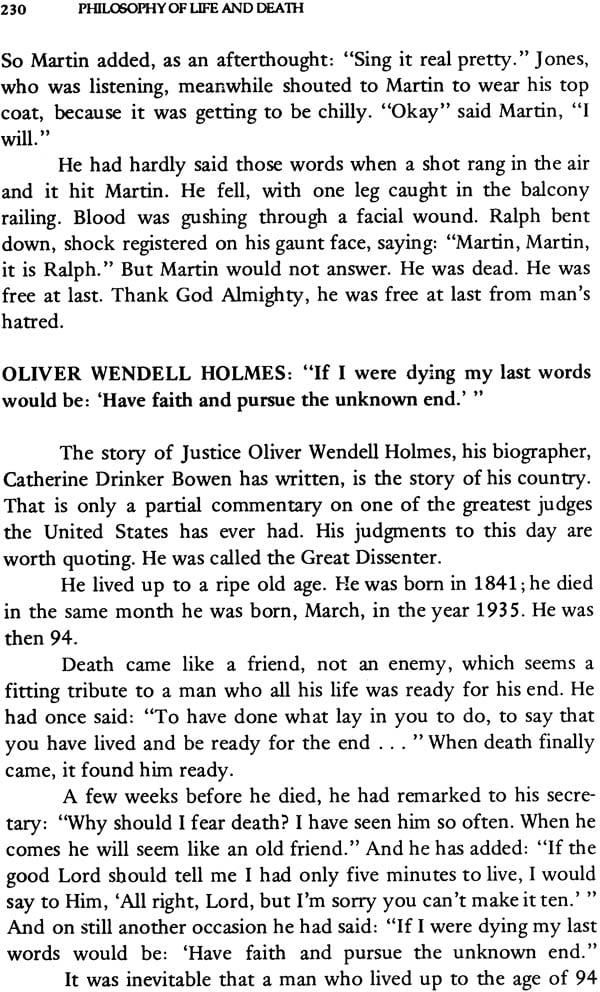
Philosophy of Life and Death
Book Specification
| Item Code: | IDE709 |
| Author: | M.V. Kamath |
| Publisher: | Jaico Publishing House |
| Language: | English |
| Edition: | 2010 |
| ISBN: | 8172241755 |
| Pages: | 350 |
| Cover: | Paperback |
| Other Details | 8.5" X 5.5" |
| Weight | 380 gm |
Book Description
From the Jacket:
In this fascinating book, M.V. Kamath helps to answer the most crucial question of existence: "What is the meaning of death?" Drawing from the wisdom, of major religions and cultures of the East and West, Kamath presents a clear, highly informative study on the experience of Life and Death. Included are the thoughts and reflections of 55 famous men and women during their experience of dying. Among them are Henry David Thoreau, Socrates, Madame Curie, W.B. Yeats, Queen Elizabeth I, Swami Vivekananda, Beethoven and Anne Boleyn. One conclusion the author draws from his examination of these intriguing experiences is that "those who are well-integrated die bravely and calmly and at peace." This book is an excellent guide to a better understanding of the experience of Life and Death.
About the Author:
M.V. Kamath (born September 7, 1921) ex-editor of the Illustrated Weekly of India, has had a distinguished career as reporter, editor and journalist in Mumbai, Bonn, New York, Paris and Washington, D.C. He has served as editor of the Free Press Bulletin, Bharat Jyoti, U.N. Correspondent, Correspondent of the Pres Trust of India, contributing editor of United Asia, and Sunday editor and Washington correspondent of the Times of India. Besides Philosophy of Life and Death he also authored Jaico Book of Baby Names, Sai Baba of Shirdi: A unique saint.
Tagore, the famous poet of the East, wanted death to reveal a secret to him. So did Tilak, a great scholar and commentator of the Bhagavad Gita. It is true that the mystery of life here and hereafter is revealed to a fortunate few. The great sages of the ancient lore knew that this birth is but one bend of the eternal stream of life. In its continuity the stream of life rushes through many avenues and finally meets the ocean. Coming out of one avenue is called death and going through another avenue is called birth. So is the case of human life. After many rounds of births and deaths, when the human being liberates itself from the self- created bondage of karma, he finally attains emancipation and perfection.
In the Bhagavad Gita it is said, "learned is he to whom the mystery of birth and death is revealed." When the body, senses, conscious mind and the two breath guards (inhalation and ex- halation) separate from the unconscious mind and the individual soul, this separation is called death. Therefore death is but a separation and not complete annihilation. Death is a habit of the body and not of the soul. Death is not painful; the fear of death is painful. Death is but a momentary disappearance which is revived again in another form. It is merely a game of hide and seek which can never mystify the wise one who knows how to look to himself and beyond.
Egotism, pride and vanity can only appear when we move around our own orbits and refuse to believe that our real orbits are not around ourselves in narrow circles, but on the widest line which goes around us all. Truth consists in the reality of that whole of which we are individual constituents. This does not mean the sacrifice of individuality. It merely means that the true individual, when properly and systematically interpreted, extends further and further, wider and wider, until it permeates through all things in the world and loses itself in the infinite completeness of the whole.
The chasm of death only obstructs our view. Our sorrow is due to our foolish refusal to see and believe that what comes next is but that which is not seen at the moment. The individual soul is self-existent, unborn, and not subject to change, death and decay. Life is like a manuscript whose beginning and end is missing. But by properly analyzing, practicing and realizing the middle portion of that manuscript, one can search for the missing pages of this manuscript of life. Who am I? From where have I come? What is the purpose of life? Where shall I go? These are the prime questions waiting for answers. You are here because you were somewhere else. You move from the known to the unknown, from visible to invisible and from seen to unseen.
The three Sanskrit words, janma, sristhi, and udpatti explain the mystery of birth and death. Birth and death are like two commas in the sentence of life. The sentence of life begins from eternity and is everlasting and never ending. The word janma means that which was hidden came forward. The word sristhi means that which was already behind the curtain came forward to the visible world. Udpatti means that which already existed in seed form came into manifestation in the plant. For a wise man, death is like a long sleep-probably for several hundred years. All the memories of our lifetimes are stored in the unconscious. That storehouse is used as a vehicle by the individual soul. Any- thing that is stored in the infinite library of the unconscious mind is called samskaras.
To properly understand the meaning of birth and death is to comprehend the entire cycle of human evolution by under- standing the twin laws of life called karma and reincarnation. These two laws should be understood first. In the cycle of the universe, a stage comes when a human being is born and thus becomes responsible for his karma. The law of karma means cause and effect mingled together. A human being can attain liberation here and now if he understands that all bondages, miseries and delusions are self-created. There is a way of obtaining freedom from these self-created miseries-it is skillful action done selflessly for others.
If we all learn to do our actions or duties selflessly, we will be doing our karmas but others will be reaping the fruits. Actually karma does not bind but the fruits therein. No human being can live without doing karma, but when he performs the karmas he has to reap the fruits. If he learns to surrender all the fruits of the karma he will be free forever. Karma .in its essential nature is a desire to perform action. Therefore, the world of desire should be understood carefully.
Desire is the motivation for our rebirth. A strong and intense desire to be reborn is the main reason for our birth. Human beings leave their mortal bodies with many desires in the unconscious mind and those desires motivate them to come to this platform again and again. So the rounds of births and deaths depend on the human motivations called desires. If we learn to reduce all our desires to a point of zero, all our motivations will be over and there will be no karma. There will be no bondage and the human being will not be in bonds for the fruits of his karma.
We live in a world of fear, anxiety, stress and strain but these are all self-created. The delusion and ignorance that are created by not realizing the true nature of the self is the main cause of all miseries. When one learns not to identify oneself with the objects of the world and constantly becomes aware of the reality or center of consciousness within, one considers birth and death voluntary actions.
As one changes one's pillow cover or book cover, so one casts off one's body. Casting off the body is called death and assuming a new garment is called birth. Attachment seems to be the mother of all miseries. When a human being gets attached to the body, he brings pain to his individual soul. But this pain and attachment can be removed by understanding that the body, breath, senses and mind are like instruments of the individual soul. He should learn the technique of living in the world yet remaining out of it.
When one knows that all the things of the world, even his body, breath, senses and mind, are his instruments, and learns how to use them by realizing that all the things that he has are for him, but are not his, then the strong sense of attachment disappears and the light of wisdom dawns. Such a fortunate one attains enlightenment and freedom from worldly fetters, as well as from the rounds of births and deaths.
Mr. M. V. Kamath, a prominent U.N. journalist, philosopher and author beautifully expresses himself and describes various ways and methods adopted by the great religious groups of the world. He gives a glimpse of the philosophy of the ancients and presents many modem writers' viewpoints on the subject. A tremendous task was accomplished. It is my sincere hope that this book will be useful, informative and enlightening to students and that they will understand the two ends of the same lifeline called birth and death.
| Author's Note | xi |
| Introduction
| xiii |
| PART I | |
| Life of Death, The Questionable Pursuit | 1 |
| Savitri and Satyavan : The Power of Love | 5 |
| The Story of Nachiketa : The Quest for Meaning | 7 |
| The Bhagavad Gita : The Interpretation of Death | 15 |
| Theory of Rebirth : The Endless Chain of Life and Death | 18 |
| The Doctrine of Lokayata : There Is No Life But This | 22 |
| Is There Life After Death? : New Evidence to the Fore | 25 |
| Reincarnation : Life, Death and the Question of Rebirth | 32 |
| Karma Revisited : Shaking One's Own Hand in Another Life | 36 |
| Nirvana : The Deliverance of the Soul | 40 |
| The Way of the Buddha and the order of the Universe | 45 |
| Bardo Thodol : A Traveler's Guide to Other Worlds | 53 |
| The Theosophist : Understanding Life and Death | 57 |
| Reincarnation and the Life Eternal | 60 |
| The Pervading Influence of the Reincarnation Doctrine | 62 |
| Sri Aurobindo on Death and Reincarnation | 68 |
| The Socratic Concept : Death and the Nature of the Soul | 74 |
| Osiris and His Forty Two Assessors | 80 |
| Zoroastrianism and the Concept of Future Rewards and Punishments | 81 |
| The Three Great Semitic Religions : Judaism, Christianity and Islam | 84 |
| Judaism and the Doctrine of Free Will | 87 |
| Man Can Control His Passions and Be a Force for Good | 89 |
| The Purpose of Creation and the Relevance of Man | 91 |
| Jewish Attitude Toward Death | 93 |
| Islam and the Idea of a Future Life | 95 |
| Iqbal's Theory : Koranic View of the Destiny of Man | 97 |
| Islamic Concepts of Heaven and Hell | 100 |
| Sufism and the Mystic of Islam | 102 |
| Christian Faith and the Concept of Personal Responsibility | 105 |
| Immortality, Life Eternal and Everlasting Life | 109 |
| Destiny, Fate and Predestination | 110 |
| The Roman Catholic Understanding Sin | 112 |
| The Doctrine of Justification by Faith Alone | 114 |
| The Sacraments and the Attaining of Salvation | 115 |
| Karl Barth and the Humanity of God | 118 |
| Dark Night of the Soul : Toward Perfect Union | 120 |
| The Question of Being : Between Finitude and Infinity | 122 |
| The Need for an Everyday Philosophy of Death | 123 |
| A Personal Philosophy | 129 |
| References
| 150 |
| PART II | 157 |
| The Lord Krishna | 161 |
| The Buddha | 163 |
| Socrates | 165 |
| Cicero | 168 |
| Jesus Christ | 170 |
| Alexander | 176 |
| Ramakrishna Paramahansa | 178 |
| William Shakespeare | 181 |
| St. Francis of Assisi | 184 |
| Sigmund Freud | 187 |
| Albert Einstein | 189 |
| Aurangzed | 193 |
| Lenin | 196 |
| Mahatma Gandhi | 198 |
| Leo Tolstoy | 202 |
| Anne Boleyn | 206 |
| Ivan Turgenev | 209 |
| Voltaire | 211 |
| Thomas More | 214 |
| Muhammad | 216 |
| Dag Hammarskjold | 219 |
| Napoleon | 223 |
| Martin Luther King Jr | 227 |
| Oliver Wendell Holmes | 230 |
| General Tojo | 233 |
| John, Duke of Marlborough | 235 |
| Swami Vivekananda | 237 |
| Thomas Jefferson | 241 |
| Pope John XXIII | 245 |
| Henrik Ibsen | 248 |
| Goethe | 250 |
| Akbar | 253 |
| Isaac Newton | 256 |
| George Gordon Byron | 258 |
| John Keats | 262 |
| Percy Blysshe Shelley | 264 |
| Queen Christina | 267 |
| Gogol | 269 |
| H.G. Wells | 272 |
| Abraham Lincoln | 274 |
| Thomas Alva Edison | 277 |
| Samuel Johnson | 279 |
| Joseph Stalin | 281 |
| Chinghis Khan | 284 |
| George Washington | 287 |
| Benito Mussolini | 289 |
| Adolf Hitler | 292 |
| Ludwig van Beethoven | 296 |
| Victor Hugo | 298 |
| Queen Elizabeth | 301 |
| Marie Curie | 304 |
| Lord Nelson | 306 |
| William Butler Yeats | 310 |
| Henry David Thoreau | 312 |
| Wolfgang Amadeus Mozart | 315 |
| Summing Up
| 317 |
| Bibliography | 326 |
| Index | 333 |
